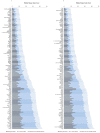Global Update and Trends of Hidden Hunger, 1995-2011: The Hidden Hunger Index
- PMID: 26673631
- PMCID: PMC4684416
- DOI: 10.1371/journal.pone.0143497
Global Update and Trends of Hidden Hunger, 1995-2011: The Hidden Hunger Index
Abstract
Background: Deficiencies in essential vitamins and minerals-also termed hidden hunger-are pervasive and hold negative consequences for the cognitive and physical development of children.
Methods: This analysis evaluates the change in hidden hunger over time in the form of one composite indicator-the Hidden Hunger Index (HHI)-using an unweighted average of prevalence estimates from the Nutrition Impact Model Study for anemia due to iron deficiency, vitamin A deficiency, and stunting (used as a proxy indicator for zinc deficiency). Net changes from 1995-2011 and population weighted regional means for various time periods are measured.
Findings: Globally, hidden hunger improved (-6.7 net change in HHI) from 1995-2011. Africa was the only region to see a deterioration in hidden hunger (+1.9) over the studied time period; East Asia and the Pacific performed exceptionally well (-13.0), while other regions improved only slightly. Improvements in HHI were mostly due to reductions in zinc and vitamin A deficiencies, while anemia due to iron deficiency persisted and even increased.
Interpretation: This analysis is critical for informing and tracking the impact of policy and programmatic efforts to reduce micronutrient deficiencies, to advance the global nutrition agenda, and to achieve the Millennium Development Goals (MDGs). However, there remains an unmet need to invest in gathering frequent, nationally representative, high-quality micronutrient data as we renew our efforts to scale up nutrition, and as we enter the post-2015 development agenda.
Funding: Preparation of this manuscript was funded by Sight and Life. There was no funding involved in the study design, data collection, analysis, or decision to publish.
Conflict of interest statement
Figures





References
Publication types
MeSH terms
Substances
Grants and funding
LinkOut - more resources
Full Text Sources
Other Literature Sources
Medical

